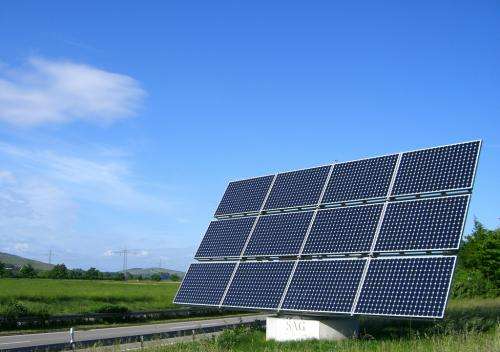Energy output of photovoltaic solar systems (pictured) can be accurately estimated using the algorithm. Credit: RQ
Researchers have developed an algorithm that can be used to simulate the hour-by-hour power output of both photovoltaic and concentrated solar thermal power systems for any location in the south-west corner of Australia.
The model is simple enough to run inside a web-browser by the general public and could be tailored to other regions around the world.
Led by Murdoch University's Dean Laslett, an engineering PhD candidate, the research forms part of a series of studies originated by Sustainable Energy Now aimed at developing an accessible and interactive computer simulation of renewable energy power systems for the South-West Interconnected System (SWIS); WA's main electricity grid.
As clouds affect how the three main components of solar radiation – direct, diffuse and reflected – reach the earth's surface, the algorithm was developed through a series of calculations using seasonal rainfall patterns and the three solar radiation components; leading to estimates of daily and hourly cloudiness across the region.
"The seasonal rainfall pattern across WA generally decreases with distance from the coast, with a zone of high rainfall in the south-west corner and the Kimberley," Mr Laslett says.
"Seasonal cloudiness follows the same pattern. Hence if the longitude and latitude of a location is converted into a distance along the coast-line and a distance inland, estimation of seasonal cloudiness can be simplified.
"An estimate of all three solar radiation components is [also] needed.
"Most modern solar devices are tilted at an angle from the horizontal which affects the three components in different ways [and] photovoltaic panels utilise all three components while concentrated solar thermal systems use only direct radiation."
The researchers extracted estimates of daily and hourly cloudiness from seasonal cloudiness by applying statistical methods from previous studies. They also counted for how cloudiness affects the three radiation components.
The model was calibrated and assessed by calculating the total horizontal surface radiation from the cloudiness data.
The results revealed the model was roughly comparable in accuracy on monthly, daily and hourly timescales to previous studies.
"Because the model can be used to estimate all three components of solar irradiance, it's possible to change the location of one or several photovoltaic or concentrated solar thermal systems and get an idea of how overall energy generation might change."
"Also because our model can run inside a web-browser, this ability becomes widely accessible to the general public … they can play around and see for themselves what a solar energy power system for the SWIS might look like."
Provided by Science Network WA






















